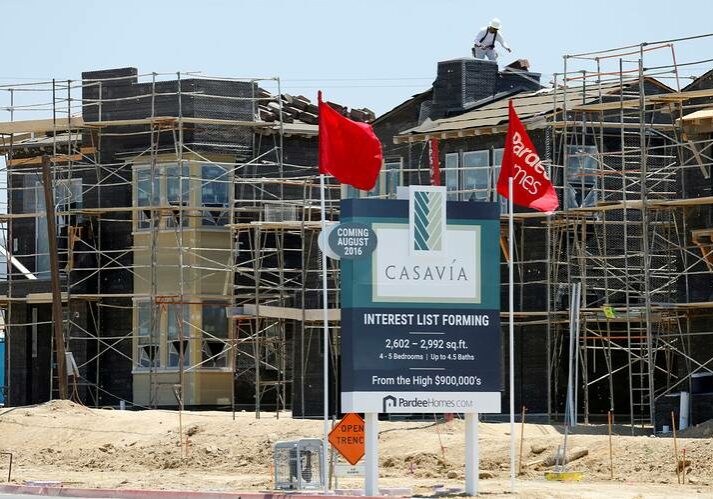Recent News
U.S. Housing Starts Rose 4.8% in June


Uptick driven by jumps in the West and the Northeast
Single-family homes under construction in San Diego on June 22. PHOTO: MIKE BLADE/REUTERS
By ANNA LOUIE SUSSMAN
Updated July 19, 2016 11:05 a.m. ET
WASHINGTON—Homebuilding in the U.S. rebounded in June, a sign demand for housing continues to firm heading into the second half of the year.
Housing starts rose 4.8% from a month earlier to a seasonally adjusted annual rate of 1.189 million in June, the Commerce Department said Tuesday.
“Homebuilding continues to gradually recover from the housing bust that accompanied the Great Recession,” said PNC chief economist Stuart Hoffman. “Demand for new single-family homes is slowly but steadily improving.”
That steadily rising demand has led to concerns about the low inventory of new and existing homes on the market, which is pushing up prices and could weigh on further expansion. But Tuesday’s report showed an estimated 1.015 million homes under construction in June, the highest level since February 2008.
June’s uptick was driven by a jump in starts in the West and the Northeast, two of the pricier regions in the country. The conditions underpinning demand are still in place, namely historically low interest rates and steady—if slowly moderating—job creation.
Starts on single-family homes, which account for roughly two-thirds of new construction, rose 4.4% in June from May, to 778,000. May single-family starts were revised down.
Starts on multifamily buildings with five or more units, which include apartments and condominiums, rose 1.6% to a rate of 392,000 in June from the prior month.
The market has swung to the single-family market over the first half of the year, with those starts up 13.2% in the first six months of 2016, compared with a year ago. Housing starts in structures with five or more apartments fell by 3.9% in the year-to-date from the same period in 2015. Still, the pace of apartment units already under construction in June hit 573,000, the highest since 1974.
New applications for building permits, a bellwether for forthcoming construction, rose 1.5% to 1.153 million, from a downwardly revised May figure. Permits have lagged behind housing starts since February, which some fear could signal weakness in the housing market going forward.
“Favorable weather conditions might help explain the overshoot in starts compared to April and May permits; either way, they’ll need to correct over the next few months,” saidIan Shepherdson, chief economist at Pantheon Macroeconomics.
The 4.8% rise handily beat the 0.9% forecast from economists surveyed by The Wall Street Journal, but home-starts figures are volatile and often revised. June’s figure came with a margin of error of plus or minus 13.5 percentage points, and May’s starts figure was revised down to 1.135 million from an initial estimate of 1.164 million.
The market got off to a slow start to the year, but overall steady housing demand in the past year has driven up home prices in many markets amid a shortage of inventory. Builders have been struggling to keep pace, with many reporting shortages of skilled construction labor and affordable lots on which to build.
A gauge of home-builder sentiment slipped to 59 in July, roughly in line with its earlier readings so far in 2016, the National Association of Home Builders said on Monday, still a positive reading.
“Builders’ optimism is solid but not rising and that is seen in the construction numbers,” said economist Joel Naroff of Naroff Economics. “We have seemingly hit a lull and permit requests and construction activity is no longer accelerating sharply.”
Housing starts in June were 2% lower than in June a year ago, and permits were down 13.6% from a year ago. Over the first half of the year, housing starts are up 7.1% compared with the same period a year ago.
Housing was a bright spot in the U.S. economy in 2015, contributing more than a quarter of a percentage point to gross domestic product growth over the year. In the first quarter of 2016, it contributed over half a percentage point to the quarter’s meager 1.1% growth rate.
Still, construction levels for new homes remain historically low relative to the levels in the 1990s and 2000s, before the last decade’s housing bubble.
Sales of existing homes rose in May, the National Association of Realtors said last month. Sales of newly built homes edged down in May, but were still at the second-highest pace since the recession ended, right behind April’s rate, the Commerce Department said last month.
Existing-home sales figures for June will be released Thursday and new home sales data will be released Tuesday, July 26.
Check out our latest video
Exploring our target industries
At Davalyn, our tenured team of niche-focused talent acquisition experts takes on the hiring challenges of a diverse and growing set of industries. Make our perspectives your most powerful recruitment and retention resource.

